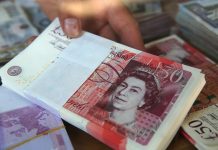GBPUSD has been regaining ground for the fourth day in a row, continuing its recovery from mid-October low of 1.2725, registered late last week. The pair exceeded the 1.29 figure and remains bullish on Wednesday. The cable saw a bounce from the lows repeatedly this week, suggesting the pair may have already found a local bottom. However, before positioning for a further ascent, it may be prudent to wait for a confirmation of a break above 1.29 on a daily basis.
It is worth mentioning that despite the current strength, the upside potential may be capped by the lingering fears of a no-deal Brexit. In the immediate term, traders could get more cautious in anticipation of the Bank of England’s Carney speech. As major central banks started to deliver stimulus measures in an effort to minimize economic risks amid the coronavirus outbreak, Carney may follow suit and deliver some dovish hints ahead of the upcoming March meeting. Of note, Goldman Sachs expects the UK central bank to cut rates by 50 basis points this month, citing the rising recession risks.
Also, the United States announce the key jobs data on Friday, and should the figures exceed expectations, the greenback could attract broad-based demand. In this scenario, the GBPUSD pair may trim weekly gains and get back below the 1.28 handle. So far, the greenback remains on the defensive after a short-lived recovery from two-week lows, registered following the Fed’s emergency rate cut earlier this week.
From the technical point of view, the pound needs to hold above the 1.29 handle in order not to lose the current upside momentum. Once above 1.2930, the pair will target the 100- and 50-daily moving averages around the 1.30 psychological mark. But considering the above-mentioned risk events, the cable will hardly be able to challenge this level until the end of the week. On the downside, the immediate support comes around 1.2870, where the 100-hour moving average lies. Below, 1.28 will come into focus again.






























